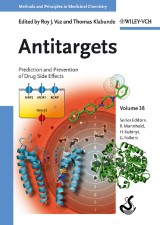Details

Antitargets
Prediction and Prevention of Drug Side EffectsMethods & Principles in Medicinal Chemistry, Band 38 1. Aufl.
|
210,99 € |
|
| Verlag: | Wiley-VCH |
| Format: | |
| Veröffentl.: | 09.04.2008 |
| ISBN/EAN: | 9783527621477 |
| Sprache: | englisch |
| Anzahl Seiten: | 504 |
DRM-geschütztes eBook, Sie benötigen z.B. Adobe Digital Editions und eine Adobe ID zum Lesen.
Beschreibungen
This practice-oriented handbook surveys current knowledge on the prediction and prevention of adverse drug reactions related to off-target activity of small molecule drugs. It is unique in collating the current approaches into a single source, and includes several highly instructive case studies that may be used as guidelines on how to improve drug development projects.<br> With its large section on ADME-related effects, this is key knowledge for every drug developer.
PART I: GENERAL ASPECTS<br> Why drugs fail: study on side effects in New Chemical Entities<br> Use of Broad Biological Profiling as a Relevant Descriptor to Describe and Differentiate Compounds: Structure-In Vitro (Pharmacology-ADME)-In Vivo (Safety) Relationships<br> PART II: ANTITARGETS: ION CHANNELS AND GPCRs<br> Pharmacological and regulatory aspects of QT prolongation<br> hERG Channel Physiology and Drug-Binding Structure-Activity Relationships<br> Qsar and Pharmacophores for Drugs Involved in hERG Blockage<br> GPCR Antitarget Modeling: Pharmacophore Models to Avoid GPCR-Mediated Side Effects<br> The Emergence of Serotonin 5-HT2B Receptors as Drug "Antitargets"<br> Computational Modeling of Selective Pharmacophores at the a1-Adrenergic Receptors<br> PART III: ANTITARGETS: CYTOCHROME P450s AND TRANSPORTERS<br> Cytochrome P450s: drug-drug interactions<br> Site of Metabolism Predictions: Facts and Experiences<br> Irreversible Cytochrome P450 Inhibition: Common Sub-Structures and Implications for Drug Development<br> MetaSite: Understanding CYP Antitarget Modeling for Early Toxicity Detection<br> Orphan Nuclear Receptor PXR-Mediated Gene Regulation in Drug Metabolism and Endobiotic Homeostasis<br> Ligand Features Essential for Cytochrome P450 Induction<br> Transporters and Drugs -<br> An Overview<br> Computational Models for P-Glycoprotein Substrates and Inhibitors<br> PART IV: CASE STUDIES OF DRUG OPTIMIZATION AGAINST ANTITARGETS<br> Selective Dipeptidyl Peptidase IV Inhibitors for the Treatment of Type 2 Diabetes: The Discovery of JANUVIA (Sitagliptin)<br> Strategy and Tactics for hERG Optimizations<br> Structure-Based In Silico Driven Optimization: Discovery of the Selective 5-HT1A Agonist PRX-00023
Roy Vaz is the head of investigative pharmacokinetics at the Bridgewater, NJ (USA) location of Sanofi-Aventis Pharmaceuticals. He received his Ph.D. in Organic Chemistry from the University of Florida, Gainesville (USA), after graduating from the Indian Institute of Technology in Mumbai (India). Prior to his present appointment, he has worked with Bristol-Myers-Squibb and Tripos. He is a specialist on the prediction and modeling of cytochrome-mediated drug metabolism.<br> <br> Thomas Klabunde obtained his PhD in chemistry from the University of Munster (Germany). After a postdoctoral fellowship at the Texas A&M University, he was appointed Assistant Professor at the Institute for Bioscience and Technology in Houston (USA). Later on, he joined the pharmaceutical research of Sanofi-Aventis in Frankfurt (Germany), where he is currently a group leader. His main interest lies with drug design approaches for G protein-coupled receptors, notably in the areas of lead finding and chemogenomics.<br>
Addressing a common challenge that is faced by every drug developer, this practice-oriented handbook surveys current knowledge on the occurrence and prevention of adverse drug reactions related to off-target activity of small molecule drugs.<br> It is unique in collating the current approaches into a single source, and includes several highly instructive case studies that may be used as guidelines on how to improve drug development projects.<br> Clearly divided into four parts, the first covers general considerations of studying and predicting side effects in drug molecules, while the second part looks at well-known anti-targets that mediate severe side effects. Part three covers the large field of ADME-related effects, focusing on the prevention of cytochrome induction and on drug transporters. The final part presents selected case studies of successful drug development in terms of suppressing unwanted side effects.<br> The result is key knowledge for medicinal and pharmaceutical chemists, toxicologists, molecular biologists, and pharmaceutists as well as drug developers working in the pharmaceutical industry.


















